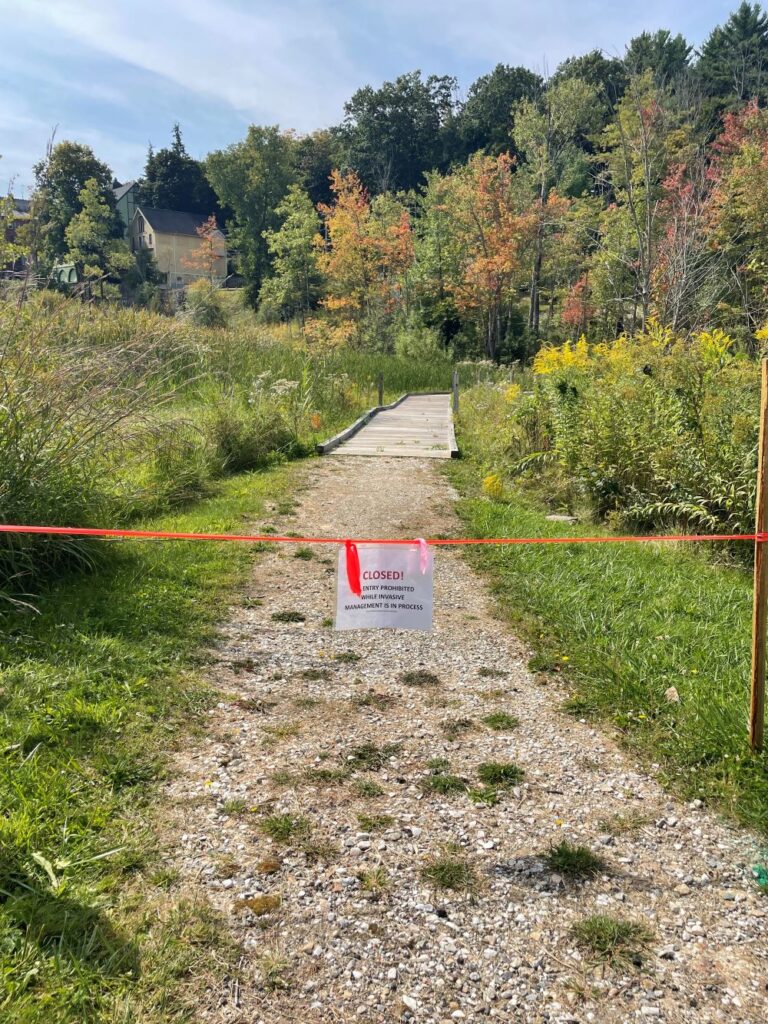city meadow progress
Invasives removed as town considers a new planting plan
By Avice Meehan

A “Closed” sign is good news for City Meadow, as it means the invasive plants are being removed to make room for planned planting in the area.
Sometimes a “closed” sign can be good news. That is certainly the case for City Meadow, where staff from Native Habitat Restoration are now treating invasive plants like phragmites and non-native cattails with a selective herbicide. Their broad-brimmed hats are barely visible above the tall growth as they work section-by-section, wiping the plants.
“Progress is being made and it’s exciting,” said Libby Borden, who chairs Friends of the Meadow.
New England aster, boneset and goldenrod bloom elsewhere in the meadow, untouched and emblematic of the future for this once-neglected slice of Norfolk. Much work lies ahead for Borden and her colleagues as they assess a robust planting plan for the Meadow shared at a public meeting in early September by Beth Roemaker of Meadowscapes.
Roemaker will lead a walk-through City Meadow on Tuesday Oct. 2 for members of the committee and town residents. She said the overall goal is to work with the ecosystems within the area to create a “natural pattern that you will see when you are out observing nature.” This means planting a “a lot of a few species” to create what she described as “little planted moments” and “natural rooms” along the boardwalk.
“When people meander through City Meadow, they should feel a sense of wonder at the natural world,” Roemaker said in her assessment. She noted that plantings should improve wildlife habitat and erosion control while also providing seasonal variation and color.
The narrow parcel, sandwiched between Route 44 and John Curtis Road, includes four distinct ecosystems that are now traversed by a boardwalk. These include woodlands, shrubland, dry upland meadow and wet meadow. Each presents a distinct challenge for both planting and long-term management.
As presented, the Meadowscapes proposal would cost roughly $300,000 over three seasons, beginning this fall with the planting of shrubs and a Black Tupelo specimen tree. Roemaker recommends planting in the wet meadow in Spring 2025 with planting of the dry slope area in Fall 2025.
Annual maintenance costs for the first three years are estimated at $33,600. The plan includes potential placements for community sculptures commissioned by the Norfolk Association, as well as opportunities for involving volunteers to remove invasives and growing plant material. Long-term management of erosion under portions of the boardwalk, as well as silting in the pond area remain open issues.
In addition to phragmites and narrow-leaf cattail, other invasive species currently found in City Meadow include vines such as porcelain berry and bittersweet; shrubs or small trees such as privet, Russian olive, various buckthorns and multiflora rose, and herbaceous plants such as reed canary grass and purple loosestrife. Mugwort, which must be sprayed in the spring, is also present in quantity.
High on Roemaker’s list of new plantings include shrubs, intended to create peninsulas that connect different ecosystems within City Meadow. These encompass wet-loving species such as high bush blueberry and cranberry, chokeberry and silky dogwood and spice bush; bottlebrush buckeye; New Jersey tea and pinxter azalea. Although she proposed minimal planting in the actual stream area, the plan does suggest introducing plants such as marsh marigold and cardinal flower.
“The next step is a budget,” Borden said at the September meeting.
Thanks to some town funding, as well as an anonymous gift, there are sufficient funds to pay for the work of Native Habitat Restoration, based in Stockbridge, Mass., and some plantings. Additional funding would need to be raised, Borden said.
